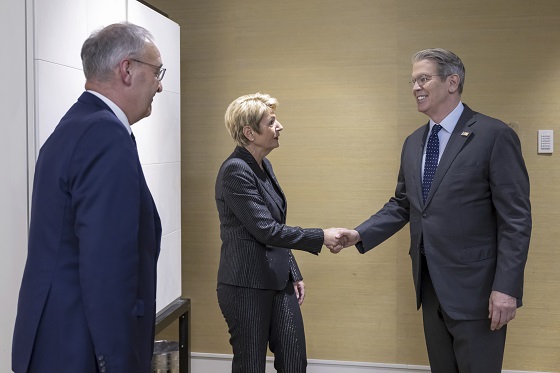Treasury Secretary trade talks with China
Washington (dpa) — US Treasury Secretary Scott Bessent plans to speak with his counterpart He Lifeng about the simmering trade conflict between the United States and China.
A conversation with the Chinese vice premier is scheduled for Friday, before the two are expected to meet in Malaysia in around a week, Bessent said during a visit by Ukrainian President Volodymyr Zelensky to US President Donald Trump at the White House.
“We hope that China will show the respect that we have shown them,” Bessent continued, expressing confidence that Trump would be able to “get things back on a good course” thanks to his relationship with Chinese President Xi Jinping. He said he thought a trade agreement was possible.
In an interview with US broadcaster Fox News, which the station published in advance on X, Trump described his threatened tariffs on China as economically unsustainable.
Asked whether the cumulative total tariff rate of 157% was sustainable for the economy and what it meant for it, he said, “It’s not sustainable, but that’s what the number is.” He claimed that China had forced him to do this.
Last week, Trump threatened to impose extra tariffs of 100% on Chinese imports into the US from November 1 and further export limits on software exports to China.
Beijing earlier announced its intention to expand its export limits on rare earths. Companies will then require a licence to export 12 of the 17 metals that are important for industry. Depending on the measure, they are set to enter force in November or December.
A meeting between Trump and Xi in South Korea, scheduled for the end of October, is eagerly awaited.
Trump said, “We’re going to meet in a couple of weeks,” and reiterated this during his comments with Zelensky.
©2025 dpa GmbH. Distributed by Tribune Content Agency, LLC.
Notes from APS Radio News
According to a number of economists, an index that might mean an economy is not as robust as it might be is called the Manufacturing Purchasing Managers’ Index (PMI).
If, for example, PMI is less than 50%, such a number might mean that the economy is weaker than expected.
Below is a report recently that was published at the National Bureau of Statistics of China:
In September, the purchasing managers’ index (PMI) of China’s manufacturing industry came in at 49.8 percent, an increase of 0.4 percentage points from the previous month. The manufacturing business climate continued to improve.
In terms of enterprise size, the PMI for large enterprises was 51.0 percent, an increase of 0.2 percentage points from the previous month, above the threshold; the PMI for medium-sized enterprises stood at 48.8 percent, a decrease of 0.1 percentage points from the previous month, below the threshold; the PMI for small enterprises stood at 48.2 percent, an increase of 1.6 percentage points from the previous month, still below the threshold.
From the sub-indexes, among the five sub-indexes that constitute the manufacturing PMI, the production index and the supplier delivery time index were above the threshold, while the new order index, the raw materials inventory index, and the employment index were below the threshold.
The production index was 51.9 percent, an increase of 1.1 percentage points from the previous month, indicating that the expansion of production in the manufacturing industry had accelerated.
The new order index was 49.7 percent, an increase of 0.2 percentage points from the previous month, indicating a continued improvement in the manufacturing market demand.
The raw materials inventory index was 48.5 percent, an increase of 0.5 percentage points from the previous month, indicating that the decline in the inventory of major raw materials in the manufacturing industry continued to narrow.
The employment index was 48.5 percent, an increase of 0.6 percentage points from the previous month, indicating an improvement in the employment of manufacturing enterprises.
The supplier delivery time index was 50.8 percent, an increase of 0.3 percentage points from the previous month, indicating that the delivery time of raw material suppliers in the manufacturing industry continued to decrease.


